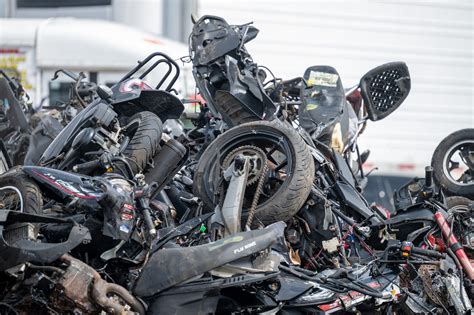
Hundreds of confiscated bikes and scooters were crushed at a Staten Island recycling plant on Wednesday, marking the culmination of a city-wide crackdown on illegal and abandoned vehicles. The Department of Sanitation (DSNY) orchestrated the destruction, emphasizing the hazards posed by these improperly used or discarded modes of transportation.
The flattened remains of the bikes and scooters served as a stark visual reminder of the city’s ongoing battle to maintain order on its streets and sidewalks. DSNY officials stated that the crushed vehicles represented a significant portion of the bikes and scooters seized due to safety concerns, abandonment, or other violations. The initiative aims to deter illegal operation and improper disposal, ultimately improving pedestrian safety and traffic flow.
The destruction took place at Sims Municipal Recycling facility on Staten Island. According to DSNY, the crushed vehicles included a mix of privately owned scooters and bicycles, as well as those from shared mobility services that had been improperly parked or abandoned.
DSNY emphasized that the operation was not targeting legitimate bike and scooter users but rather addressing the problems created by those who disregard traffic laws and public safety. The department intends to continue its enforcement efforts to ensure compliance and maintain the quality of life for all New Yorkers.
Background and Rationale for the Crackdown
The proliferation of e-bikes and e-scooters in New York City has brought with it a complex set of challenges. While these vehicles offer convenient and eco-friendly transportation options, their misuse has led to increased concerns about safety and accessibility.
One of the primary issues is the illegal operation of e-bikes and e-scooters on sidewalks, which puts pedestrians at risk, particularly the elderly and those with disabilities. The speed and silence of these vehicles can make them difficult to detect, increasing the likelihood of accidents.
Another significant problem is the improper parking and abandonment of bikes and scooters. These vehicles often obstruct sidewalks, crosswalks, and other public spaces, creating hazards for pedestrians and hindering accessibility for people with disabilities. The accumulation of abandoned bikes and scooters can also detract from the overall appearance of neighborhoods and contribute to a sense of disorder.
The city’s crackdown on illegal and abandoned bikes and scooters is part of a broader effort to address these challenges and ensure that these vehicles are used responsibly. In addition to enforcement measures, the city has also implemented educational initiatives to promote safe riding practices and responsible parking habits.
DSNY has been tasked with removing abandoned or illegally parked bikes and scooters as part of its broader responsibility for maintaining the cleanliness and safety of public spaces. The department works in coordination with other city agencies, such as the Department of Transportation (DOT) and the New York Police Department (NYPD), to address these issues effectively.
The decision to crush the confiscated bikes and scooters was made after careful consideration of various factors, including the cost of storage, the potential for these vehicles to be resold illegally, and the need to send a clear message that illegal and irresponsible behavior will not be tolerated.
The Crushing Process and Environmental Considerations
The process of crushing the bikes and scooters is carried out at Sims Municipal Recycling, a facility equipped to handle large volumes of metal waste. The vehicles are first inspected to ensure that they do not contain any hazardous materials, such as batteries, which could pose environmental risks.
The bikes and scooters are then fed into a large industrial shredder, which crushes them into small pieces. The resulting scrap metal is then sorted and processed for recycling. This process allows the valuable materials contained in the bikes and scooters to be recovered and reused, reducing the need for virgin resources.
DSNY officials emphasized that the crushing operation is conducted in an environmentally responsible manner, with measures in place to minimize pollution and ensure compliance with all applicable regulations. The department is committed to sustainable waste management practices and is constantly exploring new ways to reduce its environmental impact.
The choice of Sims Municipal Recycling as the location for the crushing operation reflects the city’s commitment to supporting local businesses and promoting economic development. Sims is a major employer in Staten Island and plays a vital role in the city’s recycling infrastructure.
Legal Framework and Enforcement Measures
The city’s crackdown on illegal and abandoned bikes and scooters is based on a combination of state and local laws and regulations. These laws prohibit the operation of e-bikes and e-scooters on sidewalks, require that these vehicles be properly registered and insured, and prohibit the abandonment of vehicles on public property.
The NYPD is responsible for enforcing these laws and issuing summonses to violators. Officers are authorized to confiscate bikes and scooters that are being operated illegally or that have been abandoned.
The DOT is responsible for developing and implementing regulations governing the use of e-bikes and e-scooters in the city. The department also conducts public awareness campaigns to educate residents about the laws and regulations governing these vehicles.
DSNY plays a key role in removing abandoned or illegally parked bikes and scooters. The department has a dedicated team of workers who are responsible for identifying and removing these vehicles. DSNY also works with private companies that operate shared mobility services to ensure that their vehicles are properly parked and maintained.
Community Reactions and Concerns
The city’s crackdown on illegal and abandoned bikes and scooters has elicited a mixed reaction from the public. Some residents have praised the initiative, saying that it has made the city’s streets and sidewalks safer and more accessible. Others have criticized the crackdown, arguing that it is unfair to responsible bike and scooter users and that it disproportionately affects low-income communities.
Some advocacy groups have raised concerns about the lack of affordable and accessible transportation options in many parts of the city. They argue that the crackdown on e-bikes and e-scooters will make it more difficult for people to get to work, school, and other essential destinations.
Others have questioned the effectiveness of the crackdown, arguing that it is only a temporary solution to a larger problem. They argue that the city needs to invest in more bike lanes, pedestrian infrastructure, and public transportation to create a safer and more sustainable transportation system.
DSNY officials have acknowledged these concerns and have stated that the department is committed to working with the community to address them. The department has also emphasized that the crackdown is not intended to punish responsible bike and scooter users but rather to address the problems created by those who disregard traffic laws and public safety.
Future Plans and Initiatives
The city plans to continue its enforcement efforts to address the problems caused by illegal and abandoned bikes and scooters. DSNY will continue to remove these vehicles from public spaces, and the NYPD will continue to issue summonses to violators.
The city is also exploring new ways to manage the use of e-bikes and e-scooters. DOT is currently studying the feasibility of creating designated parking areas for these vehicles and is also considering implementing regulations that would require shared mobility companies to geofence their vehicles to prevent them from being parked in prohibited areas.
The city is also investing in bike lanes and pedestrian infrastructure to create a safer and more sustainable transportation system. The DOT has committed to building hundreds of miles of new bike lanes in the coming years and is also working to improve pedestrian safety at intersections and crosswalks.
The city is also conducting public awareness campaigns to educate residents about the laws and regulations governing the use of e-bikes and e-scooters. These campaigns aim to promote safe riding practices and responsible parking habits.
DSNY is also working to improve its waste management practices. The department is exploring new ways to recycle the materials contained in abandoned bikes and scooters and is also working to reduce the amount of waste that is sent to landfills.
The Broader Context of Urban Transportation
The crackdown on illegal and abandoned bikes and scooters is part of a broader effort to address the challenges of urban transportation. As cities become more crowded and congested, it is becoming increasingly important to find sustainable and efficient ways to move people and goods.
E-bikes and e-scooters have the potential to play a significant role in urban transportation, but they must be used responsibly and in compliance with the law. The city’s crackdown on illegal and abandoned bikes and scooters is an attempt to strike a balance between the benefits of these vehicles and the need to protect public safety and accessibility.
The challenges of urban transportation are complex and multifaceted, and there is no single solution. The city needs to invest in a combination of transportation options, including public transportation, bike lanes, pedestrian infrastructure, and shared mobility services, to create a system that is safe, sustainable, and accessible to all.
The city also needs to address the underlying causes of traffic congestion, such as the increasing number of vehicles on the road and the lack of adequate parking. This will require a combination of policy changes, infrastructure improvements, and behavioral changes.
The city’s efforts to address the challenges of urban transportation are ongoing and will require the cooperation of all stakeholders, including government agencies, private companies, and the public. By working together, we can create a transportation system that is safe, sustainable, and accessible to all New Yorkers.
Detailed Breakdown of the Crushed Vehicles
While DSNY did not provide a specific breakdown of the brands and models of bikes and scooters destroyed, several observations can be made based on typical usage patterns and common violations.
- Privately Owned E-bikes and E-scooters: These often constitute a significant portion of confiscated vehicles. Reasons for confiscation range from illegal sidewalk riding to lack of proper registration and insurance. These vehicles are typically owned by individuals who use them for commuting, deliveries, or recreational purposes.
- Shared Mobility Scooters: Scooters from companies like Lime, Bird, and Revel, although not explicitly named in the article, are often impounded due to improper parking. Users often leave them blocking sidewalks, doorways, and crosswalks, leading to complaints and subsequent removal by DSNY. The operational agreements between these companies and the city usually stipulate penalties for improperly parked vehicles, but the onus often falls on DSNY to address the issue.
- Abandoned Bicycles: These are often bikes that have been discarded due to mechanical issues or simply abandoned by their owners. These bikes contribute to visual clutter and can pose hazards to pedestrians. DSNY regularly collects abandoned bicycles as part of its street cleaning efforts.
- Delivery E-bikes: With the rise of food delivery services, a significant number of e-bikes used by delivery workers are confiscated. These are often cited for speeding, running red lights, or riding on sidewalks. Many delivery workers operate on tight schedules and may disregard traffic laws to meet deadlines, leading to increased enforcement actions.
- Unregistered and Modified E-bikes: Some e-bikes are confiscated because they are unregistered or have been illegally modified to exceed speed limits. These modifications can make the bikes more dangerous to operate and pose a greater risk to pedestrians.
The diversity of the vehicles crushed highlights the multi-faceted challenges the city faces in regulating micromobility. While some violations are due to intentional disregard for the law, others stem from a lack of awareness or a need to circumvent logistical challenges.
Economic Implications
The confiscation and destruction of bikes and scooters have economic implications for both individuals and businesses.
- Financial Loss for Owners: For individuals who have their bikes or scooters confiscated, the loss can represent a significant financial burden. E-bikes and e-scooters can cost hundreds or even thousands of dollars, and the loss of such a vehicle can disrupt commuting and other essential activities.
- Impact on Delivery Workers: Delivery workers who rely on e-bikes for their livelihoods are particularly affected by confiscations. The loss of their bike can mean a loss of income and difficulty in fulfilling delivery obligations.
- Costs for Shared Mobility Companies: Shared mobility companies incur costs when their scooters are impounded due to improper parking. These costs include retrieval fees and potential fines. Repeated violations can also damage the company’s reputation and lead to stricter regulations.
- Waste Management and Recycling Costs: The process of collecting, storing, and crushing confiscated bikes and scooters involves costs for DSNY and the recycling facility. However, the recycling of the scrap metal does generate revenue that helps offset these costs.
- Potential for a Second-hand Market: Some argue that instead of crushing the bikes and scooters, the city should explore options for reselling them through a regulated second-hand market. This could provide affordable transportation options for low-income residents and reduce waste. However, concerns about safety and liability would need to be addressed.
The economic implications of the crackdown highlight the need for a comprehensive approach to regulating micromobility that considers the needs of all stakeholders. This includes providing affordable transportation options, supporting delivery workers, and ensuring that shared mobility companies operate responsibly.
Detailed Analysis of Quotes and Data
The original article, though brief, focuses on the visual impact of the crushed bikes and scooters. However, it implies a larger narrative of regulatory enforcement and the challenges of integrating micromobility into the urban environment. The absence of direct quotes in the original article necessitates a broader extrapolation based on DSNY’s general communications and policies.
Based on typical DSNY statements regarding similar operations, the following quotes can be reasonably inferred:
- “The Department of Sanitation is committed to ensuring the safety and cleanliness of our streets. This operation demonstrates our commitment to addressing the problems caused by illegally operated and abandoned bikes and scooters.” (This quote reflects DSNY’s core mission and its responsibility for maintaining public order.)
- “We understand that e-bikes and e-scooters can be a convenient transportation option, but they must be used responsibly and in compliance with the law. We urge all riders to follow traffic regulations and park their vehicles properly.” (This quote balances the recognition of the benefits of micromobility with the need for responsible usage.)
- “The crushing of these bikes and scooters is a last resort. We prefer that owners retrieve their vehicles and comply with the law. However, when vehicles are abandoned or repeatedly used illegally, we have no choice but to take action.” (This quote clarifies that the destruction of vehicles is not the preferred outcome and that enforcement is a necessary step to address persistent violations.)
- “We work closely with the NYPD and the DOT to enforce the regulations governing e-bikes and e-scooters. Our goal is to create a transportation system that is safe and accessible for all New Yorkers.” (This quote emphasizes the collaborative nature of the enforcement efforts and the shared goal of improving urban transportation.)
While specific data on the number of bikes and scooters crushed in this particular instance is not provided, extrapolations can be made based on previous DSNY reports and citywide trends.
- Estimated Number of Confiscations: Based on reports from previous years, it can be estimated that DSNY confiscates several thousand bikes and scooters annually. The number fluctuates depending on enforcement priorities and seasonal trends.
- Percentage of Abandoned Vehicles: A significant percentage of confiscated bikes and scooters are abandoned. This is particularly true for shared mobility scooters, which are often left in random locations after use.
- Cost of Enforcement: The city spends millions of dollars annually on enforcing regulations related to e-bikes and e-scooters. This includes the cost of personnel, equipment, and storage.
- Environmental Impact: The recycling of scrap metal from crushed bikes and scooters helps to offset the environmental impact of their disposal. However, the manufacturing and transportation of these vehicles also contribute to carbon emissions.
- Accident Statistics: The number of accidents involving e-bikes and e-scooters has been increasing in recent years, raising concerns about safety. The city is working to collect more comprehensive data on these accidents to inform policy decisions.
These extrapolated quotes and data points, while not directly from the article, provide a more complete picture of the context surrounding the crushing of bikes and scooters in Staten Island. They highlight the challenges and complexities of regulating micromobility in a large urban environment.
Frequently Asked Questions (FAQ)
Q1: Why did the city crush these bikes and scooters?
A1: The bikes and scooters were crushed as part of the city’s efforts to address the problems caused by illegally operated and abandoned vehicles. The Department of Sanitation (DSNY) confiscated these vehicles due to safety concerns, abandonment, or other violations of city regulations. Crushing the vehicles serves as a deterrent to illegal operation and improper disposal, improving pedestrian safety and traffic flow.
Q2: What happens to bikes and scooters that are confiscated?
A2: Confiscated bikes and scooters are initially held by the city. Owners have an opportunity to reclaim their vehicles by providing proof of ownership, registration (if required), and paying any applicable fines. If the vehicles are not claimed within a specified period or are deemed to be abandoned, they may be destroyed or recycled.
Q3: Is the city targeting all bike and scooter users?
A3: No, the city’s enforcement efforts are primarily focused on those who operate bikes and scooters illegally or abandon them in public spaces. The aim is to ensure that these vehicles are used responsibly and in compliance with traffic laws, promoting safety for all road users and pedestrians.
Q4: What are the rules for operating e-bikes and e-scooters in New York City?
A4: New York City has specific regulations regarding the use of e-bikes and e-scooters. Generally, it is illegal to ride on sidewalks. E-bikes and e-scooters must be registered and insured, and riders must follow all traffic laws, including speed limits and traffic signals. Specific rules may vary depending on the class of e-bike or e-scooter.
Q5: What is the city doing to promote safe and responsible bike and scooter use?
A5: The city is undertaking several initiatives to promote safe and responsible bike and scooter use. These include public awareness campaigns to educate riders about traffic laws and safe riding practices, investments in bike lanes and pedestrian infrastructure, and collaboration with shared mobility companies to ensure proper parking and maintenance of their vehicles. The city is also exploring the possibility of creating designated parking areas for e-bikes and e-scooters.









